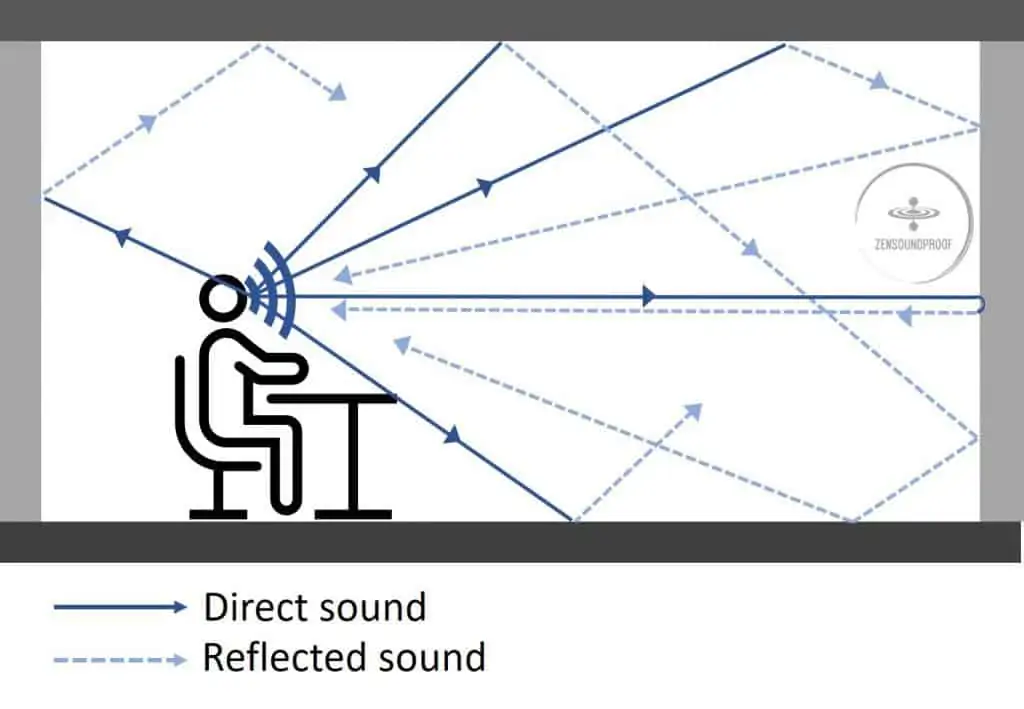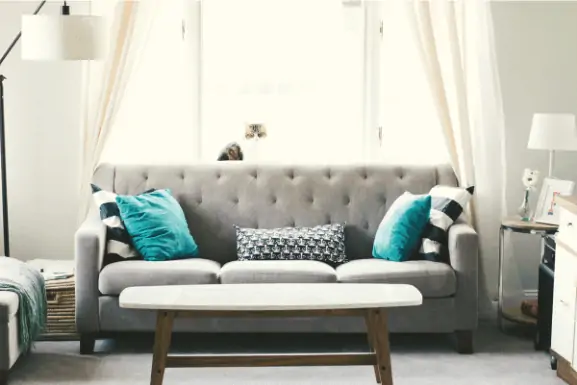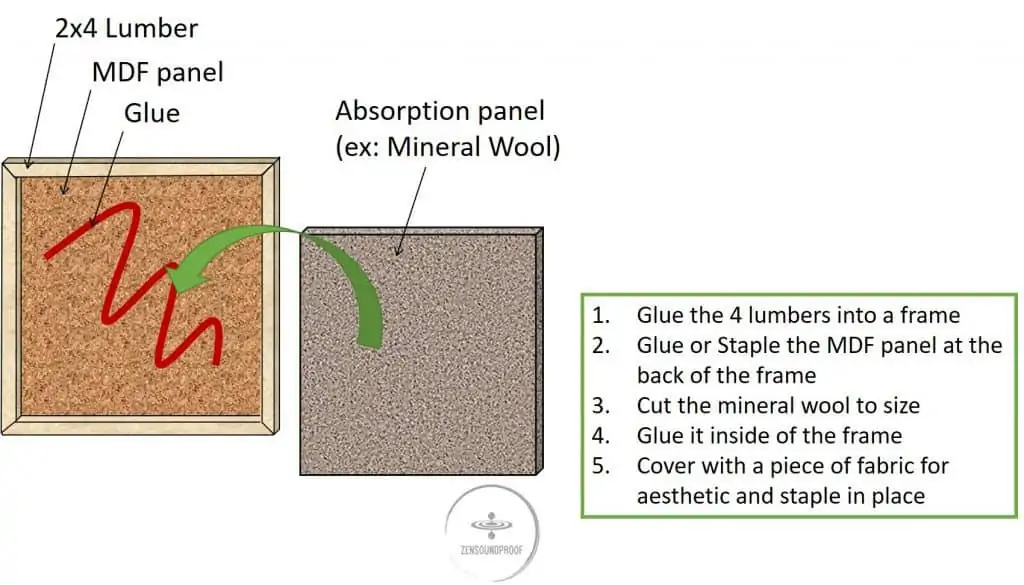If you’ve ever experienced problems with echo in your home, you know how annoying it can be.
I know budgeting for a large soundproofing project can be difficult, so I thought up ways of reducing echo in a room cheaply. Here’s my quick answer:
The best way of reducing echo in a room cheaply is to use a dedicated material, such as acoustic foam. Its open-celled structure is great for absorbing the reflective sound waves that cause echo. But if you want something more natural looking, curtains and furniture also work.
I’ll cover this in more detail below. First, it’s worth looking at the science behind echo.
The Acoustic Principle of Echo
In the process of becoming an expert on soundproofing, I spent a lot of time researching the key principles. Importantly, I realized the difference this makes to working out the best solution to your problem.
So, let’s look over the acoustic principle of soundproofing to understand how to combat it.
In short, an echo is the result of a sound wave reflecting back off a surface. It bounces back towards the source in the same way a ball does if you throw it at a wall.

But Why Does This Happen?
Well, a sound wave is a form of mechanical energy. It causes particles to vibrate, whether in the air or a medium (such as a wall).
When the wave comes into contact with a solid object it does a number of things. Some of its energy dissipates, some reflects back into the room, and the rest passes through the object. This last part is known as sound transmission.
We’re of course concerned with the bit that reflects back into the room, as this is what causes echo.
A few important points about echo are:
- Sound waves reflect off hard surfaces back into a room.
- More of a sound wave reflects off hard surfaces than soft ones.
- Echo is more common in large or empty rooms.
The reflected waves can either cause echo or reverberation. Many people assume these are the same thing, but this isn’t the case.
Echo or Reverberation?
An echo is when the reflection of the original sound is heard as a separate sound. For this to happen, there needs to be a delay between the first and second sounds. This delay is 0.1 of a second. This is the amount of time for our ear to perceive two distinct sounds.
Think of someone shouting “hello” into a canyon. You’d hear several “hellos” that get progressively quieter. Regardless, you’d hear them as separate sounds.
Reverberation, on the other hand, is when a sound persists after the original sound has stopped. Usually caused by a large number of reflected waves, your ears perceive it as one long continuous sound.
Hopefully this makes sense. If you’d like further clarification, check out this video on echo.
Principles for Reducing Echo
Soundproofing is entirely based in scientific principles, and understanding these is useful for knowing how to effectively combat echo in a room.
The main soundproofing principles are:
- Sound blocking (by adding mass)
- Sound decoupling (mechanical isolation)
- Sound absorption
- Sound damping
We won’t be using all these principles to reduce echo. The most important in this article is sound absorption. Read more to learn why.

Absorption
Absorption is exactly what it sounds like: Absorbing sound. Of course, energy can’t be destroyed, but absorption involves converting mechanical energy into heat.
The best example to use here is acoustic foam. It has an open-celled structure that effectively “traps” the sound waves.
Sound waves hit the foam, which is flexible. The waves then lose their energy by making the foam vibrate at a molecular level. These vibrations result in converting the wave’s mechanical energy into heat.
Soft and open-structured materials, such as foams, are best for sound absorbtion. Thermal insulation materials (e.g. fiberglass) can offer a good level of sound absorption.
Absorption Measurements : NRC Ratings
- A material’s ability to absorb sound is measured using the Noise Reduction Coefficient (NRC), also called Sound Absorption Coefficient (SAC).
- NRC is the ratio of absorbed energy to original energy.
- NRC is expressed as a value between 0 and 1 (1 means complete absorption).
- A material’s NRC varies depending on sound wave frequency (high to low).
Of course, harder materials have a much lower NRC than soft, open-structured ones. Here’s a table that illustrates the NRC of some common household building materials:
| NRC / Frequency | 125 Hz | 250 Hz | 500 Hz | 1000 Hz | 2000 Hz |
|---|---|---|---|---|---|
| Brick | 0.03 | 0.03 | 0.03 | 0.04 | 0.05 |
| Carpet on concrete | 0.08 | 0.25 | 0.60 | 0.70 | 0.72 |
| Wood floor | 0.15 | 0.11 | 0.10 | 0.07 | 0.06 |
| Stud walls | 0.30 | 0.20 | 0.15 | 0.10 | 0.09 |
| Ceiling tiles | 0.80 | 0.90 | 0.90 | 0.95 | 0.90 |
| Heavy curtains | 0.15 | 0.35 | 0.55 | 0.75 | 0.72 |
As you can see, softer, more open materials are much more effective at absorbing sound. This will come in useful later.
7 Ways How to Reduce Echoes in a Room
Now that we have a firm grasp of the science behind echo, we can move on to the most effective solutions.
I’ve picked these because they’re possible on even the lowest budget. While price will vary depending on the size of your room, none will break the bank.
Here are my top suggestions for how to stop echo in a room.
1. Acoustic Panels
Acoustic foam panel is obviously number one on my list because it’s designed specifically for this job. See for the next suggestions for less obvious solutions.
You can buy packs of foam online from a number of sources. Price varies massively depending on the brand. You can find more information on models here.
That said; you shouldn’t need to pay more than 90 cents per square foot.
- Make sure the foam has an open structure.
- Both peak and valley and pyramid foams have almost identical NRCs.
- Different shapes have different scatter properties.
- Look for acoustic foam panels that’s at least 2” thick.
- Be sure to cover 20-30% of the room’s flat wall surfaces for best results.
If you’re reducing echo from a noise source within a room, pay attention to its first reflection points. These are, unsurprisingly, a sound wave’s first point of contact with a solid object after leaving the source.
You can check out this video for information on how to identify first reflection points.
It’s really easy to install acoustic tiles. You could simply spray some adhesive on the wall and stick them up. If you do, be sure not to use too much, as it can block the foam’s pores and reduce its effectiveness.
Or you could use double-sided sticky tape for a less permanent solution. Make sure to choose fabric tape, though.
The only real downside of acoustic foam is that it really doesn’t look that nice. There are different colors available, but this doesn’t make much difference.
2. Bass Traps
Bass traps are a specific kind of acoustic foam designed to absorb, unsurprisingly, bass frequencies.
Their acoustic properties and design follow the same principles above, but bass traps are generally used in the corners of a room.
This is because low frequency sound waves build pressure along a room’s boundary. Corners become key reflection points for bass frequencies because the 90-degree angle is an ideal reflection point.
You can check out a standard design of bass trap that fills this brief here. Of course, you can fit bass absorbing foam elsewhere in the room; if not using corner bass traps, opt for acoustic foam panels at least 4” thick.
3. Soundproof curtains or heavy drapes
My next best suggestion is to use soundproof curtains. If you can’t get hold of any, normal heavy drapes will also work fine. You can check out some models of soundproof curtains here.
Curtains that are heavy and soft are effective at absorbing and damping sound waves.
Soundproof curtains have the added bonus of an extra layer of dense fabric or mass-rich material – anything from wool to mass loaded vinyl.
- Hang curtains in front of windows but also over walls.
- Use a rod and brackets for the highest weight allowance.
- A tension rod offers a less permanent solution.
Soundproof curtains are slightly more expensive than normal curtains, but not significantly so. Depending on the area you need to cover, you shouldn’t need to spend more than $100.
If this seems like too much but curtains are the option for you, consider looking in a thrift store. Heavy velvet curtains are much more dense than normal woven curtains.
3. Lay rugs on floors
As I showed in the table above, carpeted floors already offer a higher NRC than hardwood floors or any hard surface floors. But you can effectively reduce echo by laying rugs down too.
Rugs help to dampen sound waves that would otherwise reflect off the floor’s smooth surface. They also absorb sound waves, but are less effective at low frequencies.
- Look for rugs that are thick and fluffy, like shag rugs.
- Choose the largest rug you can possibly fit in the space.
Of course, you can spend as much as you want on a rug. But if you start looking at ones that cost several hundred dollars, you might as well just carpet the room.
4. Fit Room-Dividing Curtains
Along with hanging curtains on the walls, adding a thick room divider curtain can massively help. Simply put, you’re dividing the space into smaller parts with a sound absorbing material.
The same principles for choosing curtains apply here: the thicker the better, and look for relatively heavy materials.
Dividing a room in this way will mean there’s less space for sound waves to travel around and will reduce the number of hard, flat surfaces off which they can reflect.
5. Fill the Room with More Furniture
If possible, adding furniture to a room will massively reduce echo. Simply put, the furniture breaks up large, flat areas and helps to absorb sound waves.
- Soft furnishings such as couches and chairs work best.
- A fabric couch will be more effective than a leather couch.
- Add cushions and blankets for extra absorption.
- Tapestries are useful for hanging on walls.

Depending on the room, there might already be plenty of furniture in it. In this case, try moving the furniture around (if possible) to see if that improves matters.
Of course, this option isn’t as useful for somewhere like a kitchen, but will work in basically every other room of the house.
6. Build your own acoustic panels
If you’ve got a bit of DIY knowledge, building your own acoustic panels can be a really effective way of reducing echo in a room cheaply. This is particularly useful if you’re wondering how to eliminate echo in a large room.
For this you’ll need:
- Mineral wool insulation (such as this)
- 2×4 lumber
- MDF
- Fabric (of your choice)
- Glue and staples

Here are the steps:
- Cut 4 pieces of lumber to size to use as the frame with 45-degree angles at the ends.
- Glue them into a frame, adding a few staples for support. I recommend a minimum of 1 square foot, or bigger for larger rooms.
- Glue or staple MDF to one side of the frame.
- Cut your mineral wool insulation to fit the inside of your frame.
- Once everything is dry, insert the insulation into the frame, gluing down on the backside.
- Finally, stretch some fabric over the frame and staple in place.
You can hang these acoustic panels around the room using picture hooks or brackets. As with acoustic foam, I recommend covering up to 30% of the wall space.
7. Add bookshelves to the room
Bookshelves are surprisingly good at reducing echoes in a room, and they’re fairly cheap if you already own the books!
- Books offer plenty of mass and are useful for absorbing sound waves.
- Bookshelves provide plenty of surface area for dissipating sound waves.
- Try to block as much of the flat wall surface as possible.
Granted, there are more effective solutions on this list. But bookcases aren’t very expensive and are worthwhile if you already own lots of books. What’s more, they’re a good option if you don’t want your echo-reducing solutions to be obvious.
Final Note: Reducing Echo in a Room Cheaply
Hopefully you’ve now got a good idea of ways of reducing echo in a room. As I mentioned earlier, I believe it helps to have a solid idea of the science behind echo in order to understand how the solutions work.
My best solution is to use acoustic foam, as it was made for this job. If you don’t like its look, try one of the less obvious solutions. If you’re a hands-on type person, you can make your own DIY panel. It’s easy, customizable to your taste and size and can be a great Sunday activity.
If you have any other useful cost-effective tips, let me know in the comments below!





